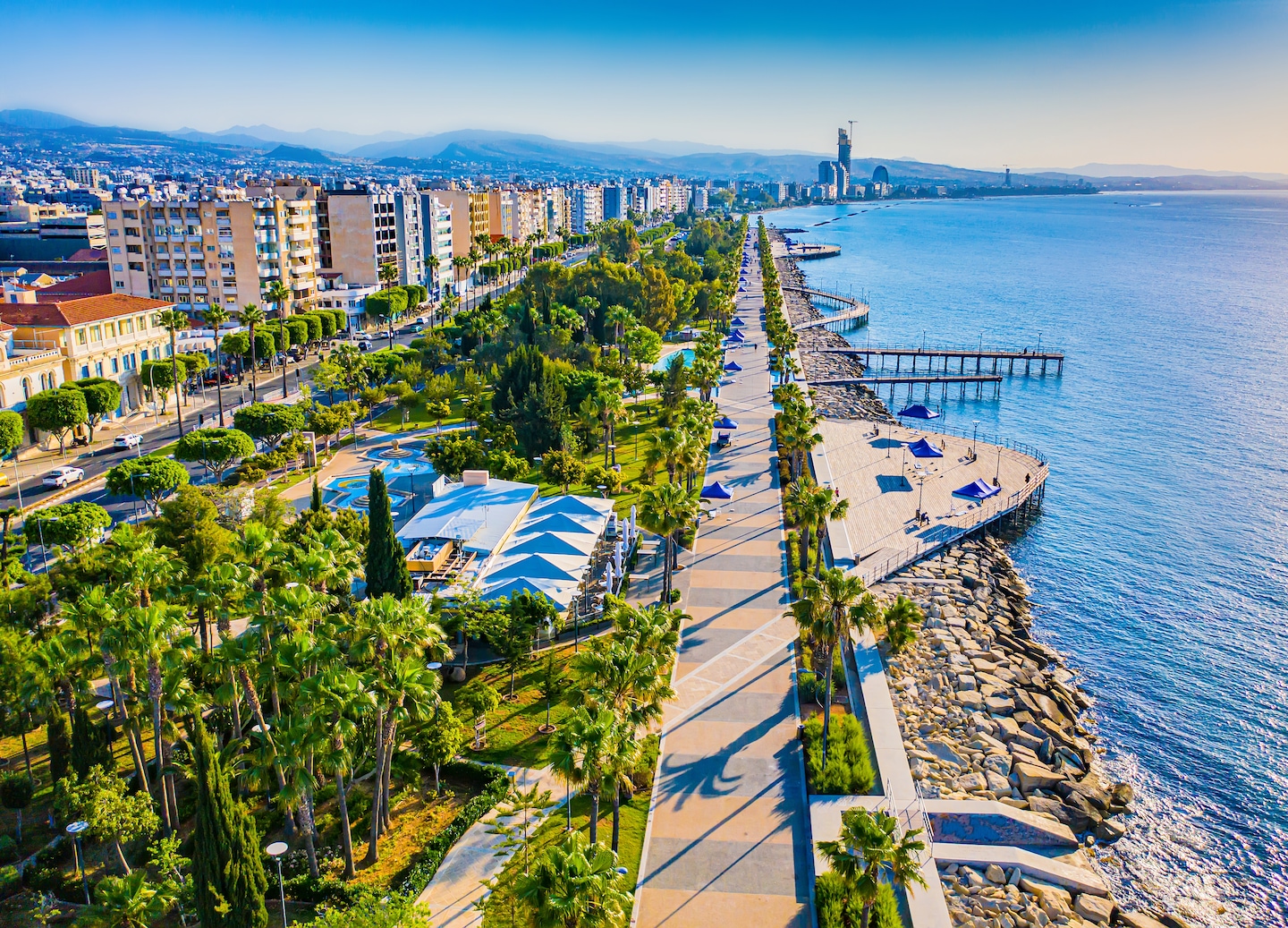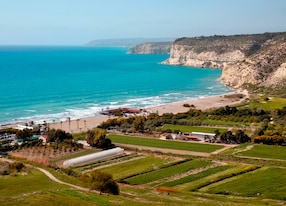The best time to visit Cyprus is from April to early June or September to October, when the island basks in sunshine, the beaches are uncrowded and the weather is ideal for both seaside relaxation and inland exploration. These shoulder seasons strike the perfect balance between warm temperatures, affordable travel and an authentic local atmosphere.
Whether you're chasing the first blooms of spring, diving into warm coastal waters or wandering through ruins without the heat of high summer, here’s your full guide to the weather in Cyprus and what each season brings.
Spring in Cyprus (March–May)

Best for: Wildflowers, archaeological sites and hiking trails
Average temperatures: 63°F (17°C) in March to 77°F (25°C) in May
Spring in Cyprus is like nature hitting the reset button. Blooming wildflowers blanket the hillsides, almond and citrus trees awaken and the island comes to life with mild temperatures and clear skies. It’s one of the best times for outdoor adventuring, whether you're trekking in the Troodos Mountains or exploring Greco-Roman ruins in Paphos and Salamis.
By April, the island’s traditional villages begin hosting local festivals and outdoor cafés open their terraces for al fresco dining. May brings even warmer weather, making it perfect for early beach days and long countryside walks lined with blossoms.
Key Events and Activities:
- Orthodox Easter celebrations (April or May)
- Flower Festival (Anthestiria) in May
- Hiking in Akamas Peninsula and Troodos trails
- Visiting ancient sites like Kourion and Paphos mosaics
- Wine tasting in villages like Omodos and Kakopetria
Summer in Cyprus (June–August)

Best for: Beach vacations, nightlife and water sports
Average temperatures: 86°F (30°C) in June to 95°F (35°C) in August
If your idea of paradise includes long sunny days and a shimmering coastline, summer is the best time to visit Cyprus. The weather in Cyprus during this season is hot and dry, with little rainfall and plenty of sunshine—perfect for lounging on beaches like Nissi, Coral Bay and Fig Tree Bay.
The island’s nightlife peaks during this time, with beach clubs, music festivals and lively tavernas staying open late. Families enjoy resort pools and water parks, while adventurous travelers dive, snorkel and parasail along the coast.
Key Events and Activities:
- Limassol Wine Festival (late August)
- Full moon beach parties in Ayia Napa
- Diving at Zenobia Wreck (one of the top wreck dives in the world)
- Sea kayaking and parasailing
- Sunset dinners by the water in Larnaca or Paphos
Fall in Cyprus (September–November)

Best for: Swimming, food festivals and fewer tourists
Average temperatures: 86°F (30°C) in September to 72°F (22°C) in November
Fall in Cyprus is like a second summer—minus the crowds. September still offers hot days and bath-like seas, while October brings slightly cooler weather perfect for sightseeing and vineyard hopping. It’s a dreamy time to explore the island at a slower pace, with a golden hue settling over olive groves and mountain villages.
As the summer crowds retreat, you’ll have more space to relax on the beaches and more opportunities for immersive local experiences. November is quieter still but remains sunny and pleasant for coastal strolls, village visits and cultural exploration.
Key Events and Activities:
- Grape Harvest Festivals (September)
- Olive and Halloumi celebrations in mountain villages
- Swimming and snorkeling into mid-October
- Touring Lefkara and other traditional craft villages
- Visiting archaeological sites in cooler temperatures
Winter in Cyprus (December–February)

Best for: Quiet escapes, cultural immersion and mountain retreats
Average temperatures: 63°F (17°C) in December to 55°F (13°C) in February
Winter in Cyprus is mild along the coast and brisk in the mountains, making it a peaceful season for cultural travel. While beach activities take a back seat, cities like Nicosia, Limassol and Paphos are perfect for museum visits, markets and historic strolls.
This is a great time to dive deeper into Cypriot traditions. You'll find fewer tourists, lower prices and a more local pace of life. Meanwhile, the Troodos Mountains offer the unique chance to ski in the morning and sip wine by the sea by afternoon. Christmas markets, cozy tavernas and carnival season celebrations give winter its own kind of charm.
Key Events and Activities:
- Christmas markets and light displays
- Skiing and snowboarding in Troodos Mountains
- Visiting Byzantine monasteries and churches
- Exploring Cyprus museums without the crowds
- Carnival season kicks off in late February
Want to Explore More of Cyprus?From ancient ruins to vibrant markets, there’s so much more to uncover. Learn what Cyprus is known for or check out what to buy in Cyprus for local keepsakes that capture the island’s timeless charm.
Frequently Asked Questions
What is the best time to visit Cyprus?
The best time to visit Cyprus is from April to early June and September to October, when the weather is warm, the beaches are quieter and travel costs are lower.
What is the weather like in Cyprus year-round?
The weather in Cyprus is Mediterranean: hot and dry in summer, mild and wet in winter and pleasant in spring and fall. Coastal areas stay warmer, while inland and mountain regions cool down more.
Can you swim in Cyprus in October?
Yes, the sea in Cyprus remains warm through most of October, especially along the southern and eastern coasts. It’s a popular month for late-season sunbathers.
Does it snow in Cyprus?
Snow is rare on the coast, but Troodos Mountains often get snow in January and February, making skiing and snowboarding possible.
Is there a rainy season in Cyprus?
Yes, December through February is typically the rainiest period in Cyprus, especially in the mountains and western coast. However, rain showers are usually short-lived.
Is Cyprus crowded in summer?
Yes, July and August are the busiest months, especially in resort areas like Ayia Napa and Limassol. For fewer crowds, visit in May or September.
What is the hottest month in Cyprus?
August is typically the hottest month in Cyprus, with daytime highs often reaching 95°F (35°C) or more, especially in inland areas.



















